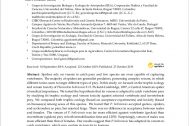Obsah
Spiders rely on venom to catch prey and few species are even capable of capturing vertebrates. The majority of spiders are generalist predators, possessing complex venom, in which different toxins seem to target different types of prey. In this study, we focused on the trophic ecology and venom toxicity of Phoneutria boliviensis F. O. Pickard-Cambridge, 1897, a Central American spider of medical importance. We tested the hypothesis that its venom is adapted to catch vertebrate prey by studying its trophic ecology and venom toxicity against selected vertebrate and invertebrate prey. We compared both trophic ecology (based on acceptance experiments) and toxicity (based on bioassays) among sexes of this species. We found that P. boliviensis accepted geckos, spiders, and cockroaches as prey, but rejected frogs. There was no difference in acceptance between males and females. The venom of P. boliviensis was far more efficient against vertebrate (geckos) than invertebrate (spiders) prey in both immobilization time and LD50. Surprisingly, venom of males was more efficient than that of females. Our results suggest that P. boliviensis has adapted its venom to catch vertebrates, which may explain its toxicity to humans.



